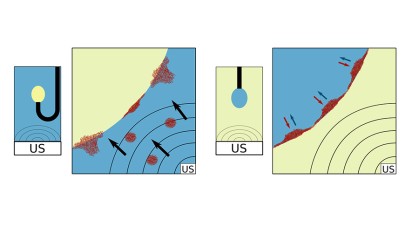Swell and shrink at the touch of a button
Interaction between soft matter and ultrasound investigated
2024/03/13 by Uta Neubauer
In the journal “Advanced Science”, researchers from TU Darmstadt describe how ultrasound affects soft matter. This could lead to new medical and industrial applications.
Ultrasound has long played an important role in medical diagnostics and many other technical applications. However, the potential of these sound waves beyond the upper audible limit of our hearing has not yet been fully utilised. In the journal “Advanced Science”, a team led by Amin Rahimzadeh and Sebastian Stock, both postdoctoral researchers at the Institute of Condensed Matter Physics now suggests further possible applications.
The TU researchers are investigating the interactions between soft matter and ultrasound. In this case, soft matter is the polymer PNIPAM (poly-N-isopropylacrylamide) in the form of tiny beads. These swell in water to form slippery microgel beads with a diameter of only around one thousandth of a millimetre. The trick: when exposed to ultrasound, the beads release the water bound inside them and shrink. When the ultrasound is switched off, they absorb water again.
Application as an active ingredient transporter
Rahimzadeh and Stock discovered reversible shrinkage by ultrasound several years ago. In “Advanced Science”, together with TU physics professor Regine von Klitzing and the working group of Mario Kupnik, professor in the Department of Electrical Engineering and Information Technology, they now present another interesting aspect.
“PNIPAM is amphiphilic, i.e. it loves both water and fat,” explains Rahimzadeh. In an oil-water mixture, the beads therefore migrate to the interface between the two liquids and thus reduce the interfacial tension. As a result, oil and water mix better. In their current study, the researchers found that ultrasound not only causes the beads to shrink, but also accelerates their adhesion to the oil-water interface. Both effects together significantly reduce the interfacial tension. This should be of interest for many industrial processes, as substances such as water and oil could be mixed with PNIPAM beads via ultrasound. In addition, the microgel can not only store and release water at the touch of a button, but also catalytically or pharmaceutically active substances.
According to Rahimzadeh, the use of the microgel beads as drug transporters in medicine is particularly promising: “Under the influence of ultrasound, they could release their cargo specifically at cell membranes and other interfaces in our body.” It will still be some time before they can be used in practice, however, as extensive safety tests and regulatory approval procedures are required for such purposes. In any case, Rahimzadeh and Stock's researchers are not primarily interested in new drug delivery systems. Instead, they want to understand in detail how ultrasound waves interact with soft particles. In doing so, they are tapping into an area that is still largely unexplored.
The publication
Sebastian Stock, Luca Mirau, Matthias Rutsch, Sonja Wismath, Mario Kupnik, Regine von Klitzing, Amin Rahimzadeh: „Ultrasound-Induced Adsorption of Acousto-Responsive Microgels at Water–Oil Interface“, in: Advanced Science, Volume 11, Issue 5, 2024 2305395, https://doi.org/10.1002/advs.202305395


